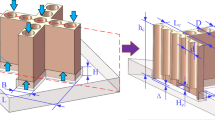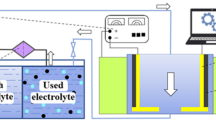Abstract
The electrochemical machining (ECM) technology is applied to the rifling processing field to solve the problem that new structure rifling with gradually changing grooves cannot be processed. By establishing the mathematical and geometric models of flow field in ECM gap, the distribution state of the deep spiral hole with gradually changing groove flow field in ECM gap was studied. By analyzing the simulation results of the flow field, it can be seen that the electrolyte is not evenly distributed in ECM gap and the electrolyte flow rate is insufficient at the tail of cathode process zone. Therefore, the cathode structure was secondarily improved to improve the electrolyte flow field distribution, so as to establish an optimized cathode model. Carry out ECM experiments of the deep spiral hole with gradually changing grooves and test experiment results under different parameters. The relationship between process parameters and deep spiral hole with gradually changing groove size can be obtained by analyzing the test results. The test results show that when the voltage varies from 12 to 18 V, the section shape of gradually changing groove rifling is respectively changed to 0.54 mm in diameter and 0.31 mm in groove width; for every 2-V increase in voltage, the average increase in diameter is 0.18 mm and in groove width is 0.10 mm. The simulation in ECM gap by using COMSOL is effectively shortening the cathode development cycle. The realization of ECM deep spiral hole with gradually changing grooves lays a technical foundation for the leap from design theory to engineering practice.














Similar content being viewed by others
References
Huo JP, Pan YT (2010) Summary of fourth generation 155 mm self-propelled artillery technology. Tech Found Natl Def 10(10):42–46
Zi W (2017) The U.S. Army is studying doubling the range of 155 mm artillery. Ordnance Mater Sci Eng (04):56–58
Yu W, Tian QT, Yu XD et al (2010) A review of erosion and wear of gun bore. J Sichuan Ordnance 310(2):97–99
Ouyang Q, Yu CG, Zhang YC (2012) Research progress on ablation and wear of artillery barrel at home and abroad. Ordnance Ind Autom 31(6):44–46
Pan YT (2007) Gun barrel design. Weapons Industry Press
Du ZH (2018) Study on optimization of certain gun rifling. Mech Eng 3:25–27
Liu ZW, Wang QL, Yu MM (2013) Failure mechanism of gun bore. J Sichuan Ordnance 34(3):47–49
Gong CH, Yang YF, Huang LH (2014) Modern artillery bore erosion wear mechanism and control measure. J Sichuan Ordnance 35(11):127–129
Wang BY, Xu YF, Zhou FM et al (2017) Study on barrel types and its dynamical effect. J N Univ China (Nature Science Edition) 38(1):42–47
Fan ZJ, Li XZ, Wang TC (2008) Electrochemical machining and composite electrochemical machining. National Defense Industry Press
Zhang ZW, Pan ZH (2008) Research for the spiral slot with big caliber tube during electrochemical machining. Electromachining Mould 3:67–69
Yang L (2014) Research on electrolytic machining method and equipment of gun barrel gradual rifle. Master’s Degree Thesis of Xihua University
Zhang YX, Li Q (2014) Brief talk the processing technology of artillery barrel. Equip Manuf Technol 2:241–242
Li B, Wang CL, Fan ZJ et al (2017) The design of equipments for horizontal electrochemical machine tool. Mach Des Manuf (4):118–121
Yu H, Fan ZJ, Fan QM et al (2016) Simulation of flow field in gap of electrochemical machining by rifle cathode of pull type with the stream. J Xi’an Technol Univ 36(2):101–107
Luo G, Fu HQ, Chen SQ et al (2016) Research on NC electrochemical machining method of gun barrel gradual rifle. Machine Tool Hydraul 44(20):14–16
Fan ZJ, Mu Q, Li QL et al (2014) Simulation of flow field in electrochemical machining of helix cavity with variable cross-section. J Xi'an Technol Univ 34(2):103–112
Li ZY, Ji H, Wang CF (2008) Cathode design of aero-engine blades in electrochemical machining based on characteristics of electric and electrolyte flow field. Proc IEEE Int Conf Autom Logist 9:1469–1473
Fan ZJ, Yang F, Zhao GG (2009) The optimization of the ECM parameters of experiment and cathode on machining mixture rifle. J Xi'an Technol Univ 29(5):428–431
Yang F, Ren TY, Wang HB et al (2017) Analysis of flow field for electrochemical machining metal screw pump stator. Int J Adv Manuf Technol 89(5/8):1317–1326
Wang MH, Zhang QF, Peng W (2014) Multiphysics coupling of electrochemical machining for spiral hole. J Nanjing Univ Aeronaut Astronaut 46(5):774–779
Yang F, Fan ZJ, Zhao GG (2010) The research of the ECM machining gap on tube rifling using COMSOL. Mach Des Manuf 4(4):125–127
Wang MH, Liu WS, Peng W (2013) Research on flow-field characteristics of gap multiphase flow and experiment of electrochemical machining of spiral deep small hole. Acta Armamentarii 36(6):748–753
Li QL, Fan ZJ, Mu Q (2014) Emulation for flow field in electrochemical machining of closed integral structure based on COMSOL. Electromachining Mould 1:28–31
Acknowledgments
The authors would like to thank professor Fan of Xi’an Technological University for her helpful suggestion, and Mr. Zhao and Mr. Guo for their kind support of this research.
Funding
The research was supported by the National Equipment Pre-Research Fund (grant no. 61406190105) and the Open Research Fund Program of Shaanxi Key Laboratory of Non-Traditional Machining (grant no. ZSKJ201411).
Author information
Authors and Affiliations
Corresponding author
Additional information
Publisher’s note
Springer Nature remains neutral with regard to jurisdictional claims in published maps and institutional affiliations.
Rights and permissions
About this article
Cite this article
Yang, F., Zhang, J., Zhao, S. et al. Analysis of flow field for electrochemical machining deep spiral hole with gradually changing groove section. Int J Adv Manuf Technol 107, 3267–3275 (2020). https://doi.org/10.1007/s00170-020-05265-2
Received:
Accepted:
Published:
Issue Date:
DOI: https://doi.org/10.1007/s00170-020-05265-2




